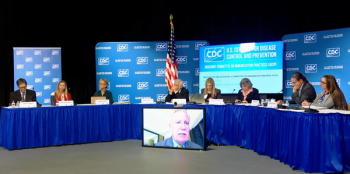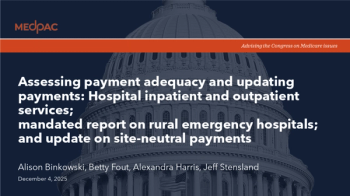
HHS offering Quality Payment Program grants to small practices
Small practices are set to receive a sizable slice of federal funding in an effort to ease their transition into the Quality Payment Program (QPP), but the shift has not started without its strains.
Small practices are set to receive a sizable slice of federal funding in an effort to ease their transition into the Quality Payment Program (QPP), but the shift has not started without its strains.
Under
Related:
Physicians have been reporting their performance through a combination of programs like the Physician Quality Reporting System, the Value-based Modifier Program, and the Medicare EHR Incentive Program. For the QPP, most Medicare clinicians will participate through the Merit-based Incentive Payment System (MIPS).
Under MIPS, physicians will be paid based on a score from four “performance categories” of cost (10% of the total score), quality (50%), clinical practice improvement activities (15%) and advancing care information (25%).
Clinicians will begin reporting through MIPS in 2017, and the first payment year for MIPS will be 2019 under CMS’ proposed rule for the program. A final rule codifying deadlines will be released this fall.
Salvatore Volpe, MD, FACP, a solo primary care practitioner in Staten Island, New York, and member of Medical Economics’ editorial advisory board thinks the timeframe is “doable,” if small practices receive the necessary resources.
Further reading:
“They [small practices] need professional guidance,” Volpe says. “You can throw all the money you want at a busy practice, but if there's no one to coordinate the details, you never build that skyscraper.”
Patient centered medical homes
Volpe uses the construction of a skyscraper as an illustration of the makeup of patient- centered medical homes (PCMHs), a practice model his has nearly a decade of experience with. He notes that a project manager is necessary to organize all the various tasks involved in creating the structure.
“With patient-centered medical homes, it's kind of the same concept [as the skyscraper], as we have more and more subspecialties, people are being evaluated through more and more narrow lenses,” he says. “You need someone who can take a step back and put all these pieces together so it makes sense.”
Patient-centered medical homes are an example of an Alternative Payment Model (APM), another path available through the QPP. Physicians might take a further approach to care transformation and use APMs, which provide lump sum payments starting in 2019, and would therefore not be subject to MIPS payment changes. Models like the Next Generation ACO Model, Comprehensive Primary Care Plus (CPC+) or Tracks 2 and 3 of the Medicare Shared Savings Program would also qualify as APMs, to name a few.
Opinion:
Volpe, an early PCMH user, as his practice became the first in New York to achieve Level 3 recognition status through the National Committee of Quality Assurance, the highest level possible.
Program offerings
The way Volpe sees it, this support in the QPP launch is similar to the start of regional extension centers, where practices will “have access to professionals who make their living improving how healthcare gets delivered,” he says.
Many of the professionals who will be assisting physicians in the QPP transition will probably have had experience with program management when regional extension centers were developing, he says.
Hot topic:
“I'm pretty sure that while there may be some new faces, many of them will be a lot of old faces from the regional extension centers,” he says. “That's a good thing. The good thing is we already have a track record in the country of helping practices get up and running.”
Organizations receiving funding, such as Quality Improvement Organizations and Regional Extension Centers, will provide small practices with training and education, and help them make decisions such as which of the program’s quality measures or electronic health record (EHR) system could be a good fit.
And that help will be needed as MIPS, “puts more risk on the doctor's side to make sure that they're on a contract that reimburses them well,” Volpe says, noting that they could see a drop in income under the new system.
Groups contest parts of the program
The Centers for Medicare & Medicaid Services invited feedback on the proposed rule this summer, and organizations like the American Medical Association responded. The group raised concerns and proposed modifications in implementing the new law
Related:
Under the low-volume threshold, clinicians or groups with $10,000 or less in Medicare charges and fewer than 100 “unique Medicare patients” would be excluded from MIPS.
However, a 2014 AMA analysis showed that only 10% of physicians and 16% of MIPS-eligible clinicians would be exempt under those thresholds. Therefore, the AMA is suggesting a change to exemptions for those with $30,000 in Medicare allowed charges per year OR fewer than 100 “unique Medicare patients.”
Time constraints
In addition to many other requests, the AMA is asking to “establish an initial transitional period” from July 1, 2017, to December 31, 2017, instead of the current January 1, 2017 rollout date, which they called “too early.”
“Physicians need to be educated about the new requirements and change their practices to accommodate the MIPS and APM programs,” the letter states. “CMS, however, is unlikely to publish the final rule before the fall of this year, leaving participants with only a few months before the proposed start date.”
ICYMI:
One of MACRA’s co-authors, Rep. Phil Roe, MD (R-Tennessee), recently told Medical Economics he has already sent a letter to CMS requesting
Newsletter
Stay informed and empowered with Medical Economics enewsletter, delivering expert insights, financial strategies, practice management tips and technology trends — tailored for today’s physicians.
















